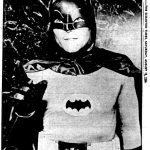“One-Adam-12,” the lady dispatcher would say. “2-11 in progress. At the bank, 20-111 Toluca Lake Boulevard. Code 2.”
Then Officer Jim Reed would key the radio mic, and answer, “10-4.”
And on their way officers Pete Malloy and Reed would be on their way to another crime.
“Adam-12” was Malloy, portrayed by Martin Milner, and Reed, played by Kent McCord, as they rode the streets of Los Angeles in their patrol unit, 1-Adam-12, between September 21, 1968, and May 20, 1975 introducing police procedures and jargon to the general public in the United States as a Central Division unit serving Downtown Los Angeles. But the show actually featured the fledgling LAPD Rampart Division station at 2710 West Temple Street as the setting for the series. This was either a production creative decision or an LAPD bureaucratic decision to showcase a new modern facility rather than the much older Central Division police station.
Many of the filming locations were in the San Fernando Valley – composed of LAPD Devonshire, Foothill, Mission, North Hollywood, Topanga, Van Nuys, West Valley, and Valley Traffic Divisions; and the garage used tow trucks from the North Hollywood Division, close to Universal Studios, which co-produced the show with Mark VII Limited.
All of Jack Webb’s, or Mark VII’s productions, were meant to be as realistic and possible, and were based on the real-life files of the LAPD. Adam-12 followed one veteran Police Officer II, P-2 Malloy, Badge 744, and his rookie partner, probationary Police Officer I, P-1, Jim Reed, Badge 2430. As it said in every episode of “Dragnet”, names were changed to protect the innocent, and covered a variety of incidents that the officers encountered during a shift, from the tragic to the trivial.
Malloy and Reed reported to shift supervisor Sgt. William “Mac” MacDonald, portrayed by William Boyett, who occasionally took a black-and-white command cruiser, a Plymouth or an AMC Matador station wagon , carrying extra police equipment. Mac’s call sign was 1-L-20 into the field. Reed once questioned why Malloy had not taken the sergeant’s exam, as he would have rated higher than Mac did. Malloy related he preferred working patrol on the street to supervision. Malloy later showed he could supervise when Mac was ill, and Malloy filled in.
The personal lives of Malloy and Reed came up on occasion and were always tied in to their duties. Malloy is a bachelor who has at least five girlfriends during the course of the series the last being Judy, played by Aneta Corsaut, while Reed is married to a woman named Jean played by several actresses, including Kristin Nelson.
The police cars they use are mostly different model years of Plymouth Belvederes, then switching to a 1972 AMC Matador for seasons five through seven.
“Dragnet”, “Adam-12”, and “Emergency!” depict different aspects of the public safety infrastructure of Los Angeles, California. There are several “crossover” episodes on each series with characters from other Mark VII shows.
Several years after “Adam-12” was canceled, Kent McCord was signed to appear in a planned third series of “Dragnet” playing Sgt. Friday’s partner, but the project was canceled due to Jack Webb’s sudden death in December, 1982. Since none of the scripts Webb wrote for the project were ever produced or released, it is not clear if he intended McCord to play a different character or to revive the Jim Reed character, although in the final episode of “Adam-12”, Reed talks about applying for an investigator’s license.
Both Milner and McCord would each go on to make two appearances in a revival of “Adam-12” that ran over two seasons from 1990 to 1991. In one episode, both actors make cameo appearances as the owners of a store in Los Angeles. Martin Milner made a guest appearance formally reprising his role as Pete Malloy, who is still an LAPD officer and has risen to the rank of Captain. Kent McCord guest stars, reprising his role as Jim Reed, who is also still with the LAPD and is now a lieutenant.
Also known as “The New Adam-12”, the series was a syndicated revival of the original. Like its daddy, this program focused on the daily jobs and lives of two police officers whose patrol car is designated “Adam-12”. This time, the officers assigned to Adam-12 were Matt Doyle – played by John Wayne’s youngest son, Ethan Wayne – and his partner Gus Grant, played by Peter Parros. This series ran two 26-episode seasons consecutively for 52 straight weeks, so although it had two seasons it ran for one calendar year. “The New Adam-12” was paired up with another revival of a Jack Webb television series: “The New Dragnet”. Both revivals were considerably different from the originals and can be considered revivals in name only.
‘The Rookies’
Willie Gillis, Terry Webster and Mike Danko got to be good friends going through the police academy, so after they became officers, Willie and Terry roomed together in the building as Mike and his registered nurse wife Jill.
They worked under the watchful eye of Lt. Eddie Ryker in the fictional SCPD, or Southern California Police Department in “The Rookies” from 1972 until 1976.
The success of Joseph Wambaugh’s book, “The New Centurions”, as well as the success with “Adam-12”, had sparked interest at the time in a more realistic depiction and storytelling of the typical uniformed police officer.
The pilot for the series was an ABC Movie of the Week which aired March 7, 1972. The TV movie features five rookies newly arrived at a police academy: cadets Jared Whitman, played by Robert F. Lyons; Kevin Lassiter, played by Jeff Pomerantz; Danko, played by Sam Melville; Gillis, played by Michael Ontkean, and Webster, played by Georg Stanford Brown, all coming from different backgrounds including the military, college and social work. The cadets’ training sergeant was Eddie Ryker, played by Darren McGavin. In the series, Sgt. Ryker was promoted to lieutenant and was played by Gerald S. O’Loughlin. The character of Jill Danko in the movie pilot was played by Jennifer Billingsley, but was recast for the series with later “Charlie’s Angels: Kate Jackson appearing as a registered nurse.
The show was produced by Aaron Spelling and Leonard Goldberg, and each episode showcased highly dramatized versions of police cases and activities, often intertwined with the off-duty lives of the officers and their significant others.
After the second season, Gillis was replaced, as Ontkean left the show over complaints in the story writing. The character Chris Owens, played by Bruce Fairbairn, replaced Ontkean.
Some of the guest stars in “The Rookies” were: Claude Akins Tom Atkins, from the original “Lethan Weapon:”; René Auberjonois and Didi Conn, from “Benson”; Joseph Campanella, from “Mannix”; Susan Dey Elinor Donahue Shelley Fabares Victor French Beverly Garland, Robert Harland Richard Hatch Pat Hingle Earl Holliman Clint Howard Rance Howard Amy Irving Don Johnson William Katt Matthew Labyorteaux Cheryl Ladd Geoffrey Lewis Cleavon Little Belinda Montgomery Roger E. Mosley Jim Nabors Charles Napier Nick Nolte Albert Popwell Don Porter Stefanie Powers (billed as Stephanie Powers John Ritter Andrew Robinson Alex Rocco William Shatner Martin Sheen Charlie Martin Smith Jaclyn Smith David Soul Sissy Spacek Craig Stevens Robin Strasser Vic Tayback John Travolta Abe Vigoda Robert Walden Ray Walston David White William Windom
‘S.W.A.T.’
I could still hear the theme song, and see them running into the back of the huge Metro van to speed off to a serious crime emergency – Luca, Deacon, Street, McCabe and Hondo.
They were the original “S.W.A.T.” which stood for Special Weapons and Tactics, a real-life special branch of the Los Angeles Police Department created by former LA Police Chief Darryl Gates to address crisis situations, like hostage situations.
This unit was called Olympic S.W.A.T. – to stand for the letter “O” – and were located in the basement of the police station.
“S.W.A.T.” starred veteran actor Steve Forrest as the unit’s leader, Lt. “Hondo” Harrelson; “Vega$” and “Spenser for Hire” star Robert Urich in his first role as as Officer Jim Street; Rod Perry as Sgt. David “Deacon” Kay, Mark Shera, later Jededian Romano J.R. Jones on “Barnaby Jones” as Officer Dominic Luca, and James Coleman as sharpshooter Officer T.J. McCabe.
That opening theme was composed by Barry De Vorzon, which became a number-one hit single in 1976 for the band Rhythm Heritage. The title sequence that used that piece was also familiar with the principal characters responding to a muster signal, grabbing their weapons and running to their specially equipped transport van driven by “Sam”, their unseen driver.
The show’s setting was rarely, if ever, specified and the shoulder patch the team members wore on their uniforms said, “W.C.P.D.” Richard Kelbaugh, a former member of the LAPD’s S.W.A.T. team, was the technical advisor for the series. WCPD stood for Western California Police Department.
The only other two recurring characters were Ellen Weston as Betty Harrelson, Hondo’s wife, and Sally Rogers from “The Dick Van Dyke Show”, Rose Marie, as Hilda, the sandwich lady.
Aaron Spelling and Leonard Goldberg were executive producers. It was created by Robert Hamner and developed by Rick Husky.
A reboot of the series occurred in 2017, Aaron Rahsaan Thomas and Shawn Ryan developed a new series for CBS which premiered on November 2, 2017. The series is produced by Original Film, CBS Television Studios and Sony Pictures Television.
This series centers on Sergeant Daniel “Hondo” Harrelson, played by “Criminal Minds” star Shemar Moore.
Some of the characters from the original recur, sort of, in the reboot.
Alex Russell portrays Officer III James “Jim” Street, a new transfer from the Long Beach Police Department. His mother Karen is in prison for murdering her abusive husband, Street’s father; she was arrested by former S.W.A.T Team Leader Buck Spivey.
Kenny Johnson plays Officer Dominique Luca – remember Dominic Luca was in the original? – a third-generation S.W.A.T officer. Johnson previously starred on The Shield, also created by Shawn Ryan.
Jay Harrington portrays Sgt. David “Deacon” Kay, a 10-year veteran of the S.W.A.T. team who was passed over for promotion in favor of Hondo. He is the only member of the team to be married and has children.
Stephanie Sigman plays Captain Jessica Cortez, the commanding officer of the LAPD’s Metropolitan Division and Hondo’s lover, and then former lover. Lina Esco plays Officer III Christina “Chris” Alonso, a former canine officer and (originally) one of the two females assigned to S.W.A.T.
Peter Onorati plays Sgt, Jeff Mumford, the team leader of another S.W.A.T Team alongside Hondo.
David Lim plays Officer Victor Tan, a former officer with the LAPD Vice Squad. He joined S.W.A.T. three years prior to the series.
Patrick St. Esprit plays Commander Robert Hicks, a senior officer with the LAPD Special Operations Bureau. He is a widower and a longtime friend of the Kay family.
Amy Farringtonp plays Detective Lt. Piper Lynch an experienced detective from LAPD Hollywood Division appointed by the mayor as a tactical consultant to Hondo’s team.
‘ChiPs’
“Ponco” Poncherello and Jon Baker rev up their motorcycles and get on the LA freeway system to chase crime.
It’s another episode of “ChiPs” – freeway pileups. By the way, for filming, traffic on Los Angeles freeways was non-existent and most chase scenes were done on back roads.
The show was created by Rick Rosner, and starred Erik Estrada as Officer Francis “Frank” Llewellyn “Ponch” Poncherello and Larry Wilcox as his partner, Officer Jonathan “Jon” Andrew Baker. With Ponch the more trouble-prone of the pair, and Jon generally the more level-headed one trying to keep him out of trouble with the duo’s gruff yet fatherly immediate supervisor Sergeant Joseph Getraer, played by Robert Pine, the two were Highway Patrolmen of the Central Los Angeles office of the California Highway Patrol – CHP, hence the name CHiPs.
As real-life CHP motor officers rarely ride in pairs, in early episodes this was explained away by placing the trouble-prone Ponch on probationary status, with Jon assigned as his field training officer. Eventually, by the end of the first season, this subplot faded away as audiences were used to seeing the two working as a team.
In the fifth season, 1981–82, Estrada went on strike over a dispute over syndication profits. As a result, he did not appear in seven episodes; for that period he was replaced by Bruce, now Caitlyn Jenner.
Despite their successful pairing on-screen, Wilcox and Estrada did not always get along behind the camera. It was Wilcox’s falling-out with the producers over what he saw as continual favoritism toward Estrada that saw Wilcox not return for the sixth and final season. Wilcox was replaced by Tom Reilly, as Officer Bobby Nelson.
Bruce Penhall, a native of Balboa Island, Newport Beach and a motorcycle speedway rider who had won the 1981 and 1982 Speedway World Championships, was also introduced as cadet–probationary officer Bruce Nelson, Bobby’s younger brother in 1982–83.
According to “TV Guide”, show creator Rick Rosner was a reserve deputy with the Los Angeles County Sheriff’s Department. During a coffee break on an evening patrol shift in the mid-1970s he saw two young CHP officers on motorcycles which gave him the idea for this series. He later created 240-Robert, which seemed like a hybrid of “ChiPs” and “Emergency!”.
Episodes occasionally reference Jon Baker’s service in Vietnam. This makes his character one of the earliest regular – and one of the more positive – portrayals of a Vietnam veteran on television. Indeed, Larry Wilcox served 13 months in Vietnam as a Marine artilleryman.
CHiPs ’99 is a reboot with some of the same actors promoted to higher ranks in the CHP.
This time, Jon Baker as a Captain and Joe Getraer is the CHP Commissioner. Other original cast members were Officer Frank Poncherello returning from a 15-year hiatus from the CHP, Officer Barry Baricza and Arthur (Artie) “Grossie” Grossman as a detective. Bruce Penhall also returns as newly promoted Sergeant Bruce Nelson.
‘T.J. Hooker’
Sgt. Thomas Jefferson “T.J.” Hooker was a 15-year veteran plainclothes Lake City Police Department (LCPD) detective whose partner was killed in the line of duty while he and Hooker were trying to stop a bank robbery. An angry Hooker becomes motivated to rid the streets of criminals like those who murdered his partner. Thus, he decides the only way he can do it is to return to his former position as a uniformed patrolman.
In “The Protectors,” the series’ pilot/TV movie, Hooker, back in uniform, trains a group of police academy recruits, including Adrian Zmed. Hal Williams plays a senior officer, and Richard Herd makes a brief appearance as Captain Dennis Sheridan, Hooker’s tough but understanding superior. During most of the series, Hooker is partnered with brash, sometimes hot-headed young rookie Vince Romano, played by Zmed. Hooker acts as his mentor both professionally and socially. The age difference generally being the key hook of the partnership, the pair quickly became fast friends and a good team.
Outside of his work, Hooker is divorced as a result of his work putting a strain on his marriage, but he is friendly with his ex-wife Fran, a nurse. A ladies’ man, Hooker is still trying to adjust to being single again. Lee Bryant was the original actress to portray Fran; the part is later played by Leigh Christian.
Hooker’s tough, no-nonsense demeanor has him often clashing with station Captain Sheridan, but he always got the job done and was highly respected as a result. Introduced at the start of the second season was attractive Officer Stacy Sheridan, portrayed by Heather Locklear, the daughter of Captain Sheridan, who attended the police academy. Initially brought in to replace Vicki, by the end of the season she had progressed to patrolling with Jim Corrigan, played by “Time Tunnel” vet James Darren, another veteran cop much in the mold of Hooker.
The series was created by Rick Husky who had also worked on “The Rookies” for Aaron Spelling and Leonard Goldberg. The series was originally to be a reworking of that former cop show, this time called “The Protectors”. After the pilot, it was decided to focus the series on William Shatner’s character and retitle it “T. J. Hooker”. The series initially set out to give a more “hands on”, procedure-based view of police work than some of the more stylized cop shows of the 1970s and 1980s, evident in the very early episodes.
‘Hill Street Blues’
“You be careful out there,” Sgt. Phil Esterhaus would caution the watch meeting of the Hill Street precinct before he dismissed them to the field in “Hill Street Blues,” which
aired on NBC from January 15, 1981, to May 12, 1987.
The show chronicles the lives of the staff of a single police station located on Hill Street in an unnamed large city. Although filmed in Los Angeles – both on location and at CBS Studio Center in Studio City – the series is set in a generic unnamed inner-city location with a feel of a U.S. urban center in the Midwest or Northeast. Producer Steven Bochco reportedly intended this fictional city to be a hybrid of Chicago, Buffalo, and Pittsburgh.
The “blues” are the police officers in their blue uniforms. The show received critical acclaim and its production innovations influenced many subsequent dramatic television series produced in the United States and Canada.
In its debut season, the series won eight Emmy Awards, a debut season record later surpassed only by “The West Wing”. The show received 98 Emmy nominations during its run.
The series featured a strong focus on the workplace struggle between what is right and what works. Many episodes took place over the course of a single day, concluding with Capt. Frank Furillo, portrayed by Daniel J. Travanti, and public defender Joyce Davenport, played by Veronica Hamel, in a domestic situation, often in bed, discussing how their respective days went.
The series dealt with real-life issues and employed professional jargon and slang to a greater extent than had been seen before on television.
“Hill Street Blues” employed what was, at that time, a unique style of camera usage for weeknight television productions, such as filming close in with action cuts rapidly between stories.
Rather than studio, or floor, cameras, handhelds were used to enhance this style. Overheard, off-screen dialogue aurally-augmented the “documentary” feel with respect to the filmed action of a scene.
The theme song for “Hill Street Blues” was written by Mike Post, featuring Larry Carlton on guitar. It was released as a single and became a major US hit, reaching #10 on the US Billboard Hot 100 in November 1981. It was also an Adult Contemporary hit in the US and Canada.
‘Joe Forrester
Lloyd Bridges starred as Joe Forrester, a uniformed foot patrol officer in a run-down neighborhood of Los Angeles.
Patricia Crowley, a native of Olyphant, near Scranton, co-starred as Georgia Cameron, Joe’s romantic interest. Former NYPD Detective Eddie Egan played Sgt. Bernie Vincent, Joe’s supervisor.
Joe Forrester’s character was introduced on the TV anthology series “Police Story”, in a special 90-minute episode “The Return of Joe Forrester”, written by Mark Rodgers and directed by Virgil W. Vogel, later retitled “Cop on the Beat”, and syndicated as a TV-movie.
In this pilot, Forrester, a second generation policeman, is a plainclothes officer in LAPD’s Metro Division who convinces his superiors to put him back in uniform, and back on a foot beat, in a neighborhood beset by a series of armed robberies which are invariably followed by a vicious rape. When the case is solved, Forrester elects to stay in uniform, and on his foot beat, leading to the subsequent series.
Forrester is a veteran cop in Los Angeles, assigned to a foot beat. He is a highly respected officer in the community, effectively fighting crime every day because, as a foot patrolman, he is able to keep personal contact with the people he protects, building trust and empathy. Like other cops, he busts thieves, drug dealers, murderers, and other criminals who threaten the residents of his beat.
‘The Blue Knight’
“The Blue Knight” is a similar character in a CBS crime series, running in 1975 and 1976, starring George Kennedy as Officer Bumper Morgan. The show was based on the 1973 novel of the same name by Joseph Wambaugh and produced by Lorimar Productions. It was also inspired by the 1973 TV film “The Blue Knight”, starring William Holden, which ran before the TV show premiered.
Bumper Morgan is a veteran police officer in Los Angeles, who continues to patrol the streets in uniform. The series dealt with Morgan’s daily dealings with dangerous criminals and drug dealers.
Guest stars included: Jim Davis, from “Dallas” and “Rescue 8”; Robert Hays, from “Angie” and “Airplane”, and Gerald McRaney, from “Simon and Simon”.
After a run of twenty-six episodes the series was canceled by CBS.
TRIVIA QUESTIONS THIS TIME:
QUESTION: What was TJ McCabe’s full name in “S.W.A.T.”?
ANSWER: Travis Joseph “T.J.” McCabe.
Q. What other TV cop was Georg Stanford Brown from “The Rookies” married to?
A. Brown, who player Officer Terry Webster in “The Rookies”, was married to Tyne Daly, Mary Beth Lacey, from “Cagney and Lacey”.
Q. What movie did Larry Wilcox star in that was a remake of a classic war movie?
A. Wilcox was in the reboot of “The Dirty Dozen: The Next Mission” in 1985.
Q. What TV show did Adrian Zmed star in aside from “TJ Hooker”?
A. Zmed was host of “Dance Fever” 1985-87.
TRIVIA FROM LAST TIME
QUESTION. The name “Sonny Crockett” had previously been used in another TV show. Which was it?
ANSWER. The name was used for a criminal played by actor Dennis Burkley on “Hill Street Blues” in 1983, where “Miami Vice” creator Anthony Yerkovich was a writer. Coincidentally, Gregory Sierra – also Chano on “Barney Miller” – who later played Crockett’s boss on “Vice” appeared in the same episodes.
Q. Actor John Diehl, who played Det. Larry Zito, and actor Michael Talbott, who played Det. Stan Switek on “Miami Vice”, played in high-profile movies before the series. Can you name them?
A. Diehl played the character Cruiser in “Stripes” in 1981 with Bill Murray, and Talbott played Officer Morgan – the Highway Patrol officer who pulls over Philo Beddoe at the end of “Any Which Way You Can” in 1980, and Clyde the ape punches him in the face and knocks him out.

Jim Dino is the business writer for The Standard-Speaker, Hazleton. Reach him at jdino@standardspeaker.com.




